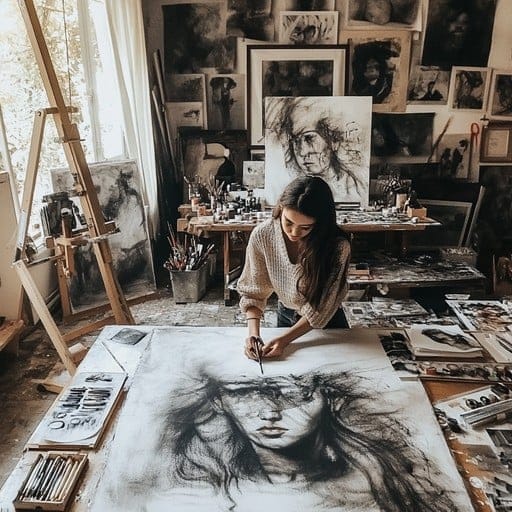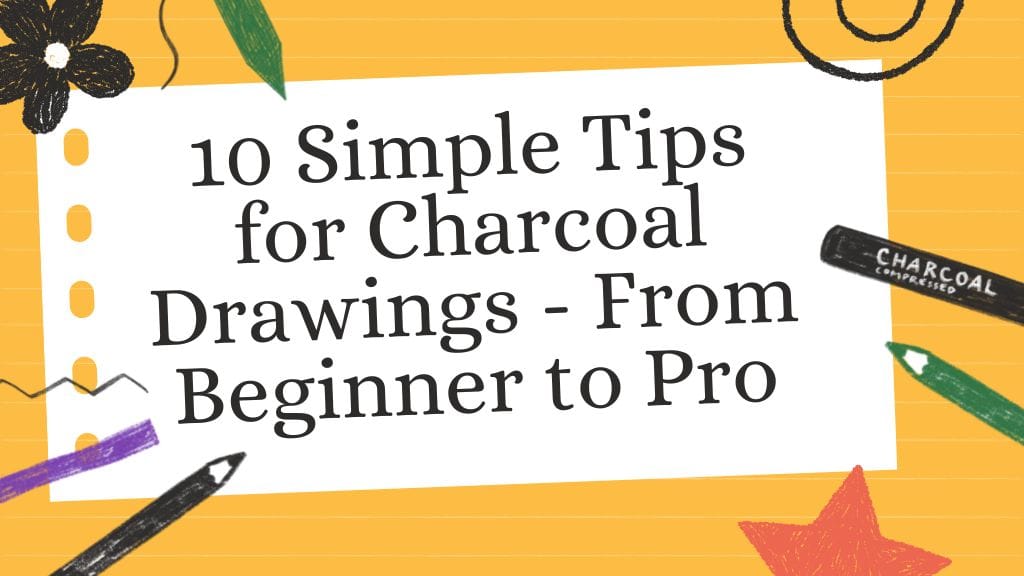Why Charcoal Drawing Still Captivates in 2025
Tips For Charcoal drawing is a powerful, timeless art form that allows artists to explore bold contrasts, deep emotion, and expressive detail. Whether you’re picking up charcoal for the first time or refining your skills, learning the right techniques is key to creating stunning artwork.

In this updated guide, you’ll discover 10 expert-approved charcoal drawing tips — perfect for beginners and even intermediate artists looking to sharpen their technique in 2025.
10 Simple Tips for Charcoal Drawings to Elevate Your Art
1. 🧰 Gather the Right Charcoal Drawing Supplies
Start with high-quality materials:
- Charcoal pencils: for detail work (soft, medium, and hard)
- Vine charcoal & compressed sticks: for shading and bold strokes
- Charcoal paper: look for textured, heavyweight options
- Blending stumps, kneaded eraser, fixative spray
Your tools will shape the outcome, so invest wisely.
2. 🌗 Master Value and Contrast Early On
Understanding light, mid-tones, and shadow is essential in charcoal drawing. Use layering and pressure control to create dramatic contrasts. This adds depth and realism to your art.
Try creating a value scale before every drawing session to warm up and train your eye.
3. 🥚 Start with Simple Subjects
Don’t dive into portraits right away. Begin with:
- Basic shapes (spheres, cubes, cylinders)
- Still-life objects (cups, fruits, vases)
- Black-and-white photo references
This helps develop foundational skills like composition and proportion.
4. ✍️ Learn How to Blend Like a Pro
Blending softens harsh lines and adds realism. Use:
- Blending stumps for precision
- Your fingers for broader smudges
- Tissue or cotton pads for smooth gradients
Pro tip: Avoid over-blending — keep some textures visible for character.
5. 🌾 Explore Textures and Effects
Charcoal can mimic a variety of textures — smooth skin, rough stone, soft fabric. Try:
- Cross-hatching for roughness
- Scumbling for dreamy, cloud-like effects
- Lifting charcoal with a kneaded eraser for highlights
Experimenting leads to stylistic breakthroughs.
6. 🔲 Use Negative Space Strategically
Negative space (the area around your subject) helps:
- Improve composition
- Achieve better proportion
- Create visual balance
Instead of just drawing the object, focus on the shapes around it. This strengthens your observation skills.
7. 🔍 Work from General to Specific
Start loose, then refine:
- Sketch basic forms lightly
- Add large shadow areas next
- Leave the details for last
This step-by-step approach prevents proportion errors and lets your drawing “breathe.”
8. 🧾 Try Different Paper Tones
Charcoal looks dramatically different on:
- White paper: high contrast, sharp highlights
- Toned gray/brown paper: moodier, more atmospheric
- Black paper: reverse shading technique using white chalk for highlights
Switch it up to expand your style.
9. 🖼️ Use Reference Images — Don’t Copy Blindly
References help, but don’t become dependent on copying:
- Observe light direction, anatomy, and structure
- Add your own interpretation and creativity
- Change background or pose for originality
This helps you develop your artistic voice.
10. 🔁 Practice and Patience Are Your Best Tools
Charcoal drawing is a skill — not a talent. Set aside time to:
- Sketch daily (even 10 minutes helps)
- Study other artists’ charcoal techniques
- Try figure drawing or still life challenges
Consistency leads to confidence.
🎯 Final Thoughts: Start Your Charcoal Art Journey Today
Tips for Charcoal drawing in 2025 remains one of the most expressive and accessible mediums for artists. By mastering these tips, you’ll unlock new creative potential and bring your ideas to life with bold, stunning strokes.
Whether you’re drawing portraits, landscapes, or abstract forms, these foundational techniques will serve you every step of the way.
